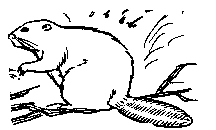The objectives of this project are to design a bridge to span 80 feet across the Little Washougal River from a take-off on the W-2070 road and to design a culvert crossing of the first stream on the Mine Creek road system. These crossings are designed to accomodate four design vehicles: Cat 245 excavator on lowboy, Washington 137 yarder, Skagit T-90 yarder, standard logging truck. Follow this link to the Vehicle Specifications. This project also meets the objective of providing the University of Washington Senior Forest Engineering Design Class with a realistic and practical design experience. The project site is located in western Skamania County, near Washougal, Washington. It is located in Township 3 North, Ranges 5 and 6 East, Willamette (WM). The Little Washougal River is classified as a type 1, fish-bearing stream. Mine Creek is a type 4, potentially fish-bearing stream. There are two water crossings involved in this project: Mine Creek and the Little Washougal River. To allow for comparison, four methods were used to determine the discharge for these streams. These are the Log-Pearson III, USGS regional peak flow, the rational method, and the Campbell-Sidle method. For the Mine Creek crossing, the values from the USGS method were used for the final product. Q100, used to determine the culvert dimensions needed to pass the maximum flow, is 64.3 cfs. Q2, used to determine the water level at lower flows (necessary for fish passage), is 22.8 cfs. The values from the Log-Pearson III method were used for the Little Washougal River. Q100 was determined to be 2,025 cfs. This value was then used to determine the clearance requirements for the bridge crossing. We considered several bridge types and designs for their suitability in crossing the Little Washougal River. These types include glue-laminated wood stringers (glulam), concrete, portable, and log stringers. We ruled out log stringer bridges during the adolescent stages of the project due to the length of the span (80 feet) and the lack of availability of very large logs. We performed most of the analyses on glulam bridges. The results for several configurations of glulam bridges are in the Glulam Bridge Comparison Worksheet (see appendices). The best design used four glulam stringers 12.25 in wide and 48 in deep. We obtained information on concrete bridges and portable bridges from varying companies specializing in these products (see references). The concrete, portable, and glulam bridge types all meet the requirements for the Little Washougal River crossing. Further investigation of cost and expected lifetime indicated that the prestressed concrete design was the best option. The Mine Creek crossing presented many challenges because of the potential need for fish passage. We developed two designs (a culvert and a pipe arch) to deal with the question of fish passage. The design culvert has a diameter of 60 inches, is 68 feet long, and lays at a slope of 13%. This culvert will pass the 100 year flows, but it is doubtful if the culvert will allow fish passage. The pipe arch will be 65 inches wide by 40 inches tall. It will allow 100 year flows to pass, and has the advantage of not disturbing the natural streambed. Further ivestigation of the presence of fish at this crossing of Mine Creek is needed to choose a final design. Road design for this area was completed by the 1998 University of Washington Forest Engineering Senior Class. After reviewing their results, we found the design to be sufficient. Some additional work was required to determine necessary curve widening and fill slopes at each crossing. At Mine Creek, 20 feet of fill is necessary at a 1:1 fill slope ratio to afford the proper culvert or pipe arch placement. 14 feet of curve widening is necessary on the curve crossing Mine Creek to allow a 5 axle truck to cross the creek. At the Little Washougal crossing, some fill work is necessary at the approaches. This is because the bridge is raised considerably to allow passage of 100 year flows. The curve connecting W-2070 to the bridge may also need some curve widening. Data on this curve is unavailable at this time. However, there is sufficient space to allow for any required curve widening. Due to the span length required at the Little Washougal River crossing, a log stringer bridge design is unsatisfactory. Three alternative bridge types do meet safety requirements: Glue-Laminated wood bridges, concrete bridges, and portable bridges. At the Miner Creek crossing, fish passage considerations and a tight curve radius severely limit design options. Due to the tight curve, a bridge is infeasible. If it is determined that Miner Creek is inadequate for fish habitat, a standard culvert may be used. A pipe arch can be used to allow fish passage without forcing a change in the positioning of the road. The design road is adequate. However, the radius of the curve approaching the Little Washougal river crossing may need to be increased to allow passage of critical vehicles, and there must be some curve widening on the Mine Creek crossing. |
